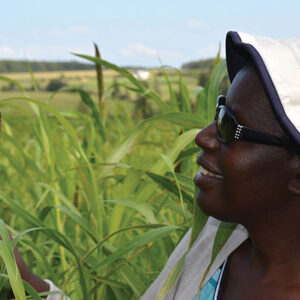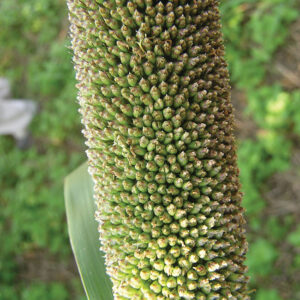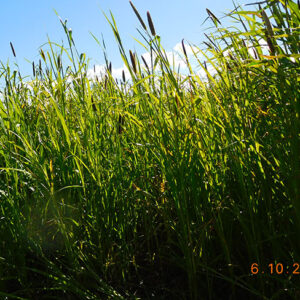
Features
Cereals
It’s millet time
Packed with nutrients and resistant to climate stress, the resilient grain has promise as a biofuel additive and yield-boosting cover crop.
September 26, 2023 By J.P. Antonacci
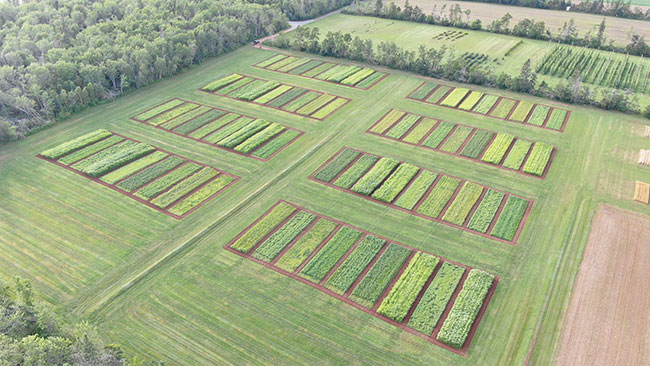 Aerial view of the cover crop trial plots at AAFC-Charlottetown.
Photo courtesy of Stephanie Arnold, University of Prince Edward Island Climate Lab.
Aerial view of the cover crop trial plots at AAFC-Charlottetown.
Photo courtesy of Stephanie Arnold, University of Prince Edward Island Climate Lab. Tiny millet packs a big nutritional punch, and could be used to wallop world hunger.
Relatively rare in North America when compared to more popular cereal grains like wheat and maize, millet is a dietary staple in Asia and Africa, where the tiny superfood thrives in hot, harsh conditions that would stymie other crops.
The Food and Agriculture Organization (FAO) of the United Nations declared 2023 the International Year of Millets, highlighting the vitamin-rich grain’s potential to help reduce so-called “hidden hunger,” which sees a quarter of the world’s population eat food that is lacking in nutrients.
As a crop with a short growing season that can succeed in poor soil with little fertilizer and water, millet is ideal for a warming world. Agriculture and Agri-Food Canada (AAFC) considers millet a “nutritionist’s dream” because the grain is naturally gluten-free and a dense source of protein, fibre, antioxidants and essential minerals like iron and zinc.
With an estimated 12,000 acres of millet grown in Canada, according to AAFC research scientist Raju Soolanayakanahally, this country’s millet production pales in comparison to global powerhouses like India, which harvests more than 12 million tons each year – over 40 per cent of the global millet market.
With the global population continuing to increase and arable land under threat due to the changing climate, the United Nations sees “resilient” cereals like millet as part of the solution to food security, and one way to mitigate swings in maize and wheat harvests that affect the food supply.
As the FAO puts it, millet varieties “grow in harsh and dry conditions, providing food when other harvests fail.” Millet also reduces soil degradation and enhances soil health, helped by the plant’s ability to resist drought, thrive in the heat, and tolerate crop disease and pests.
The FAO says an increase in millet production in countries like Canada would help millet “resurface in our markets and on our tables (and) contribute to healthy diets and a healthy environment.”
In Canada, millet is mainly grown as animal feed and birdseed, with smaller production for use in flour, multigrain bread, cereal and other foodstuffs. But several AAFC research projects are finding innovative ways to use millet to increase crop yields, make soil healthier and even generate biofuel.
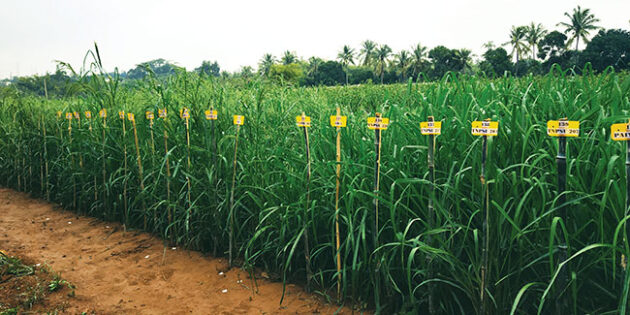
Millet as a cover crop has become a common sight on Prince Edward Island due to its benefits to the soil and pest management.Photo courtesy of Agriculture and Agri-Food Canada.
Millet supports spuds
Millet has become a common sight on Prince Edward Island, where more and more potato growers are turning to pearl millet as a cover crop that boosts yields by suppressing pests and enriching the soil.
“In the last six years, we have seen increasing numbers of growers growing pearl millet,” says Judith Nyiraneza, an AAFC research scientist based in Charlottetown.
Nyiraneza’s experiment, through AAFC’s Living Lab Atlantic initiative, compared eight cover crops grown with and without manure – plus a negative control with bare soil – on 72 large potato plots. The study was conducted over one growing season, which in P.E.I. is about 120 frost-free days.
After replicating the experiment four times, Nyiraneza concluded that pearl millet returns more carbon to the soil than legumes such as red clover – previously the Island’s most popular potato cover crop – and alfalfa.
Millet even outperforms another warm-season grass crop, sorghum-sudangrass, in terms of reducing nitrate leaching into the Island’s sandy soil – and then into the groundwater sources that supply P.E.I.’s drinking water – and in suppressing populations of root-lesion nematodes, which are microscopic, worm-like organisms that cut into potato yields by infecting the plant’s root system and hampering its ability to absorb nutrients.
“It’s very rare to see a cover crop that is combining these benefits. So we were very happy to see those results,” Nyiraneza says.
“It was a really nice story because the number of root-lesion nematodes was lower, the amount of carbon returned to the soil was higher, the nitrate-leaching risk was lower, and it was boosting yield.”
Potato growers had already embraced pearl millet as a viable cover crop. Thanks to Nyiraneza’s research, they now have data to quantify how effective the cover crop is at squeezing out nematodes and returning carbon to the soil through crop residue.
For example, Dahu Chen, an AAFC-Fredericton phytopathologist collaborating with Nyiraneza recorded 1,400 root-lesion nematodes in a kilogram of soil that has grown pearl millet, versus 3,000 pests per kilogram in soil in which red clover had been grown. Pearl millet can also lower greenhouse gas emissions through carbon sequestration, though its exact effectiveness is still being quantified as the evaluation takes some years.
As a bonus for growers, pearl millet is comparable in price to, or in some cases even cheaper than, typical cover crop options like red clover and alfalfa.
“I think our growers just need some scientific numbers to show the changes in soil quality or in yield,” Nyiraneza says. “But they already know that pearl millet is a good cover crop.”
Millet as biofuel
In Quebec, AAFC research scientists Annick Bertrand and Gaëtan F. Tremblay are looking into how sweet pearl millet can be turned into a source of high-quality silage and a sugar-rich biofuel additive.
This dual purpose is achieved by pressing the plant’s stalk twice, with the juice collected for bioethanol production and the leftover plant material, called the bagasse, used as silage.
The process is based on the same principle as processing sugar cane. The trick, Bertrand says, is not pressing all the “sugary juice” out of the stalks.
“Because in the lab, when we do the pressing to the last drop, there’s no more sugar in the bagasse,” says Bertrand, a forage crop physiologist and biochemist. But even after double-pressing in the field, there is still some residual sugar left in the stalk, which leaves the bagasse with sufficient carbohydrate and nutrient composition to be useful as high-quality silage
The AAFC researchers and their team spent years testing many types of presses in the lab, measuring the sugar concentration and the quantity of juice obtained from each method of pressing.
“We finally concluded that the hydraulic press was the one that was the most practical and can be used in the field,” Bertrand says.
The hydraulic press does not get blocked with leaves and other biomass, and can be deployed in the field with minimal modification. The millet stems are pressed immediately upon harvesting, with two pressings of 90 seconds each. Speedy extraction is essential because the sugars inside the stalk degrade over time, meaning in-field pressing gets the highest return, Bertrand explains.
A tropical cereal, millet can grow up to 14-feet tall. But the plant is cut before maturity when used for biofuel production “because we want the sugar to be in the stalk” and not the grains, Bertrand says. There is “practically no grain” in the bagasse, she adds, because the plant is cut before it fully flowers.
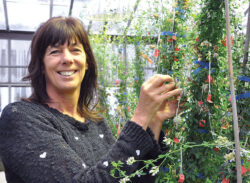
AAFC’s Annick Bertrand has been looking into how sweet pearl millet can be turned into a source of silage and biofuel additive.
Photo courtesy of TC Media.
Sweet pearl millet is a forage millet, as contrasted to grain millets, which are grown for their seeds, have a longer maturing process and are not as well adapted to Canadian weather. Forage millets have been bred to have a higher sugar content, making them suitable for biofuel and animal feed.
“It’s higher than any other forage crop, but it’s lower than sugarcane or maize,” Bertrand says of sweet millet’s sugar content.
Sweet sorghum slightly outperforms sweet millet in terms of sugar yield, she adds, but both are “very promising” options for Canada to increase bioethanol production because they are better adapted to extreme temperatures “and can grow under conditions that are not optimal for maize or other energy crops.”
“These species have advantages compared to maize because they are more drought-resistant and they don’t need that much water or fertilizer,” Bertrand says.
Her lab has come up with an idea for industry: hydrate the dried maize grain used to make bioethanol with millet juice instead of water, adding even more sugar to the mix and therefore producing more biofuel. “It’s a direct equation – the more sugar concentration you add, the more efficient the transformation to ethanol,” Bertrand says.
With it being “relatively simple” for growers to set up and use the hydraulic press in their own fields, and with millet able to be grown on poor-quality soil unsuitable for corn, Bertrand could see millet production scaling up in Canada as its benefits for biofuel become more widely known. She says, “In the context of climate change and the production of bioethanol, I think these plants are promising.”
